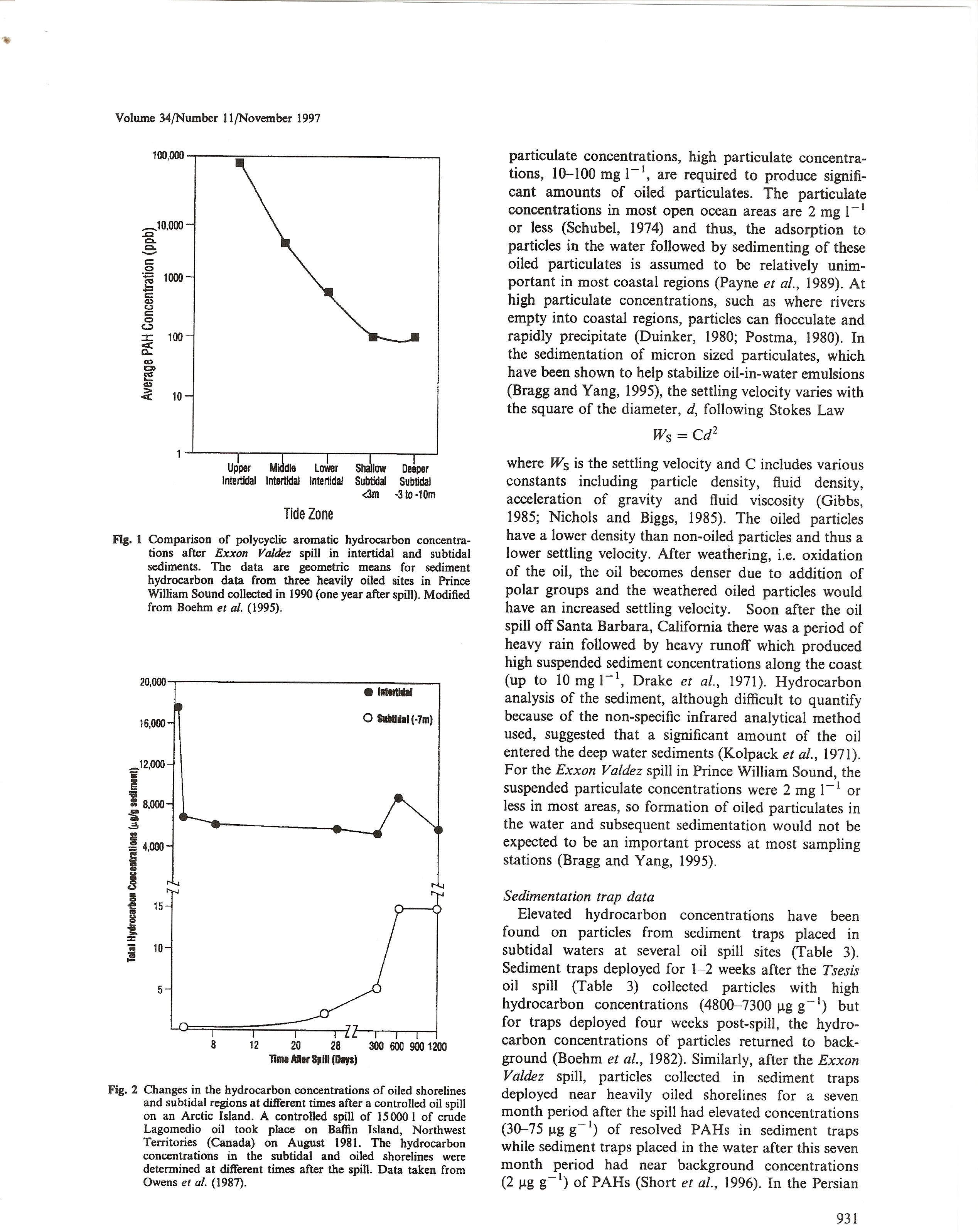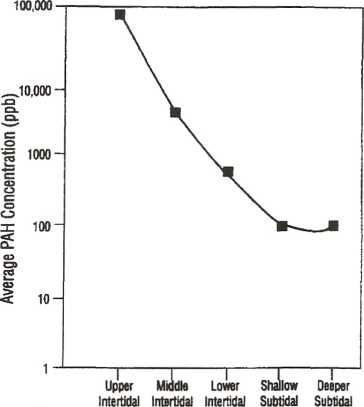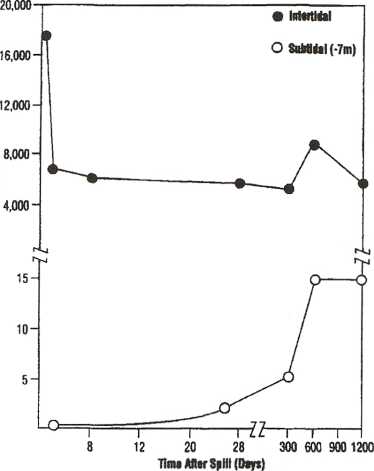39447 scan0025 (4)

Volume 34/Numbcr ll/November 1997

<3ffl -3 to-1 Om
Fig. 1 Comparison of polycyclic aromatic hydrocarbon concentra-tions after Exxon yaldez spili in intertidal and subtidal sediments. The data are geometrie means for sediment hydrocarbon data from three heavily oiled sites in Prince William Sound collected in 1990 (one year after spili). Modified from Boehm et al. (1995).
Tide Zonę
Totil Hydroorbm Concentraliont (mi/b smUimM)

Fig. 2 Changes in the hydrocarbon concentrations of oiled shorelines and subtidal regions at different times after a controlled oil spili on an Arctic Island. A controlled spili of 150001 of crude Lagomedio oil took place on Baffin Island, Northwest Territories (Canada) on August 1981. The hydrocarbon concentrations in the subtidal and oiled shorelines were determined at different times after the spili. Data taken from Owens et al. (1987).
particulate concentrations, high particulate concentrations, 10-100 mg l-1, are reąuired to produce signifi-cant amounts of oiled particulates. The particulate concentrations in most open ocean areas are 2 mg l-1 or less (Schubel, 1974) and thus, the adsorption to particles in the water followed by sedimenting of these oiled particulates is assumed to be relatively unim-portant in most Coastal regions (Payne et al., 1989). At high particulate concentrations, such as where rivers empty into Coastal regions, particles can flocculate and rapidly precipitate (Duinker, 1980; Postma, 1980). In the sedimentation of micron sized particulates, which have been shown to help stabilize oil-in-water emulsions (Bragg and Yang, 1995), the settling velocity varies with the square of the diameter, d, following Stokes Law
= Cd2
where fVs is the settling velocity and C includes various constants including particie density, fluid density, acceleration of gravity and fluid viscosity (Gibbs, 1985; Nichols and Biggs, 1985). The oiled particles have a lower density than non-oiled particles and thus a Iower settling velocity. After weathering, i.e. oxidation of the oil, the oil becomes denser due to addition of polar groups and the weathered oiled particles would have an inereased settling velocity. Soon after the oil spili off Santa Barbara, California there was a period of heavy rain followed by heavy runoff which produced high suspended sediment concentrations along the coast (up to 10 mg l-1, Drakę et al., 1971). Hydrocarbon analysis of the sediment, although difficult to ąuantify because of the non-specific infrared analytical method used, suggested that a significant amount of the oil entered the deep water sediments (Kolpack et al., 1971). For the Exxon Yaldez spili in Prince William Sound, the suspended particulate concentrations were 2 mg l-1 or less in most areas, so formation of oiled particulates in the water and subseąuent sedimentation would not be expected to be an important process at most sampling stations (Bragg and Yang, 1995).
Sedimentation trap data
Elevated hydrocarbon concentrations have been found on particles from sediment traps placed in subtidal waters at several oil spili sites (Table 3). Sediment traps deployed for 1-2 weeks after the Tsesis oil spili (Table 3) collected particles with high hydrocarbon concentrations (4800-7300 pg g-1) but for traps deployed four weeks post-spill, the hydrocarbon concentrations of particles returned to back-ground (Boehm et al., 1982). Similarly, after the Exxon Yaldez spili, particles collected in sediment traps deployed near heavily oiled shorelines for a seven month period after the spili had elevated concentrations (30-75 pg g-') of resolved PAHs in sediment traps while sediment traps placed in the water after this seven month period had near background concentrations (2 pg g_l) of PAHs (Short et al., 1996). In the Persian
931
Wyszukiwarka
Podobne podstrony:
scan0031 (3) Volume 34/Number ll/November 1997 Massachusetts and the Amoco Cadiz off the Brittany co
22634 scan0033 (3) Volume 34/Number ll/Novcmbcr 1997 Yaldez Oil Spili: Fate and Ęffects in Alaskan W
scan0027 (3) Yolume 34/Number ll/November 1997 carbon concentrations. Experimental verification of t
scan0023 (5) Volume 34/Number U/November 1997 PAH depending on its degree of weathering. As a genera
scan0020 (6) 349 PETROLEUM AND INDMDUAL POLYCYCLIC AROMATIC HYDROCARBONS Oil spilled on land has lit
scan0029 (2) Yolume 34/Number U/November 1997 result of weathering, such as evaporation and degrada-
więcej podobnych podstron